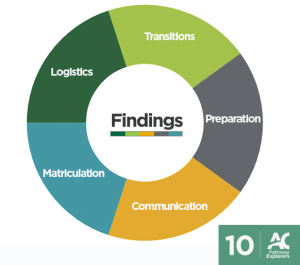10 year – Findings
 Personal interviews and an online survey questioned students about their experiences into, through and beyond the Dual Credit Program. The scope of the data focused on awareness, experience during the program, overall satisfaction and the pathway of students post dual credit experience.
Personal interviews and an online survey questioned students about their experiences into, through and beyond the Dual Credit Program. The scope of the data focused on awareness, experience during the program, overall satisfaction and the pathway of students post dual credit experience.
Imperative for our study was that our students interviewed and those surveyed were representative of the diverse backgrounds of the Dual Credit Programs. Through a concerted effort, an authentic student voice has been achieved.
From our conversations and data collected, five themes emerged. Significantly, feedback and shared experiences were very positive.
A |
Transitions: Differences between High School and CollegeMost students stated that the Dual Credit Program was a good fit. Although many initially had some apprehensions, most were able to adjust and transition into the college culture successfully.
|
B |
Logistics: Scheduling and TransportationThe majority of students were able to fit in a Dual Credit Program quite easily into their schedule and transportation was not a concern for most. For some students, travel time and a demanding high school schedule made taking a Dual Credit Program at the college most challenging.
|
C |
Preparation: Orientation Clarity and ConsistencyMany of our students were well prepared for the Dual Credit Program. For those who struggled, some either did not attend the Orientation session due to the time offerings or did not find the information delivered at the session was specific enough.
|
D |
Communication: The Role of Caring AdultsThe vast majority of our students spoke very encouragingly about the adults they encountered while in a Dual Credit Program. Support and accessibility was outstanding and readily available. We can never underestimate the importance of good communication and the role the “Caring Adult” plays in this program.
|
E |
Matriculation: Life after Dual CreditThere was a substantial number of students who chose to attend college or an apprenticeship training program post their Dual Credit Program. Even for those going into programs unrelated to their Dual Credit Program, the experience was affirmed to be worthwhile.
|